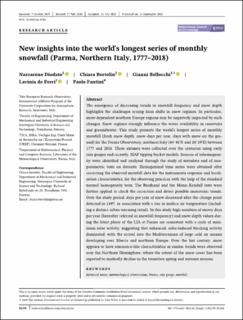| dc.contributor.author | Diodato, Nazzareno | |
| dc.contributor.author | Bertolin, Chiara | |
| dc.contributor.author | Bellocchi, Gianni | |
| dc.contributor.author | De Ferri, Lavinia | |
| dc.contributor.author | fantini, paolo | |
| dc.date.accessioned | 2021-01-19T09:16:37Z | |
| dc.date.available | 2021-01-19T09:16:37Z | |
| dc.date.created | 2020-09-17T09:14:05Z | |
| dc.date.issued | 2020 | |
| dc.identifier.citation | International Journal of Climatology. 2020, 1-17. | en_US |
| dc.identifier.issn | 0899-8418 | |
| dc.identifier.uri | https://hdl.handle.net/11250/2723594 | |
| dc.description.abstract | The emergence of decreasing trends in snowfall frequency and snow depth highlights the challenges arising from shifts in snow regimes. In particular, snow‐dependent southern Europe regions may be negatively impacted by such changes. Snow regimes strongly influence the water availability in reservoirs and groundwater. This study presents the world's longest series of monthly snowfall (fresh snow depth, snow days per year, days with snow on the ground) for the Parma Observatory, northern Italy (44°48′N and 10°19′E) between 1777 and 2018. These datasets were collected over the centuries using early rain gauges and recently, SIAP tipping bucket models. Sources of inhomogeneity were identified and analysed through the study of metadata and of nonparametric tests on datasets. Homogenized time series were obtained after correcting the observed snowfall data for the instruments response and localization characteristics, for the observing practices with the help of the standard normal homogeneity tests. The Buishand and the Mann–Kendall tests were further applied to check the correction and detect possible monotonic trends. Over the study period, days per year of snow decreased after the change point detected in 1897, in association with a rise in surface air temperature (including a distinct urban warming trend). In this study high numbers of snowy days per year (hereafter referred as snowfall frequency) and snow depth values during the latest phase of the LIA at Parma are consistent with a cycle of minimum solar activity, suggesting that enhanced, solar‐induced blocking activity dominated, with the arrival into the Mediterranean of large cold air masses developing over Siberia and northern Europe. Over the last century, snow appears to have resonance‐like characteristics as similar trends were observed over the Northern Hemisphere, where the extent of the snow cover has been reported to markedly decline in the transition spring and autumn seasons. | en_US |
| dc.language.iso | eng | en_US |
| dc.publisher | Wiley | en_US |
| dc.rights | Navngivelse-Ikkekommersiell 4.0 Internasjonal | * |
| dc.rights.uri | http://creativecommons.org/licenses/by-nc/4.0/deed.no | * |
| dc.title | New insights into the world's longest series of monthly snowfall (Parma, Northern Italy, 1777–2018) | en_US |
| dc.type | Peer reviewed | en_US |
| dc.type | Journal article | en_US |
| dc.description.version | publishedVersion | en_US |
| dc.source.pagenumber | 1-17 | en_US |
| dc.source.journal | International Journal of Climatology | en_US |
| dc.identifier.doi | 10.1002/joc.6766 | |
| dc.identifier.cristin | 1830695 | |
| dc.description.localcode | © 2020 The Authors International Journal of Climatology published by John Wiley & Sons Ltd on behalf of Royal Meteorological Society. This is an open access article under the terms of the Creative Commons Attribution‐NonCommercial License, which permits use, distribution and reproduction in any medium, provided the original work is properly cited and is not used for commercial purposes. | en_US |
| cristin.ispublished | true | |
| cristin.fulltext | postprint | |
| cristin.qualitycode | 1 | |

